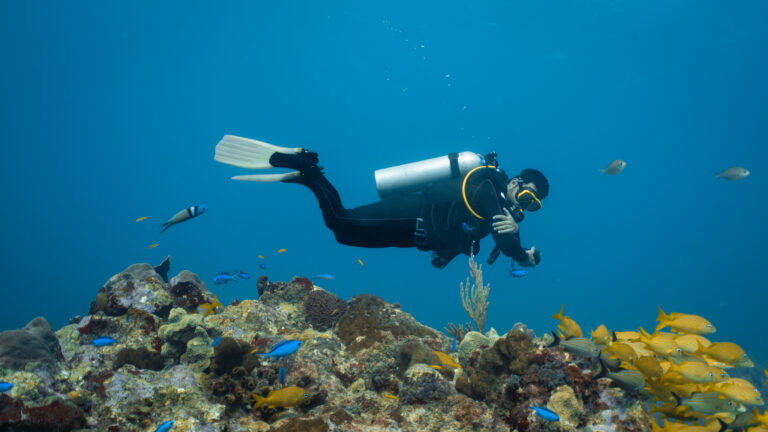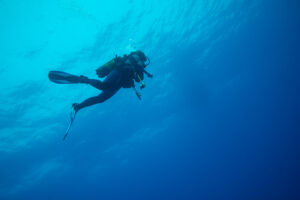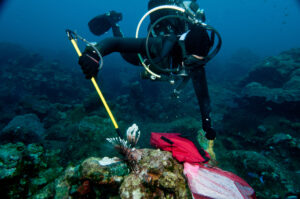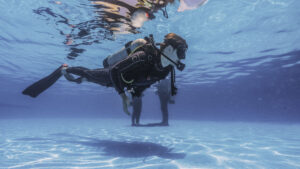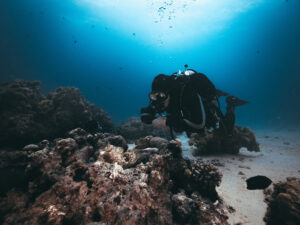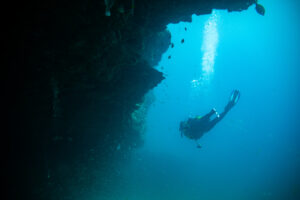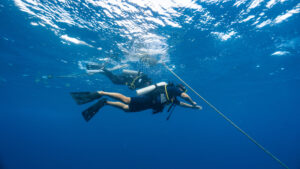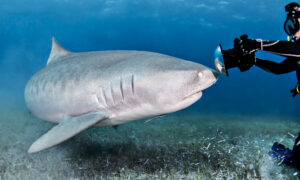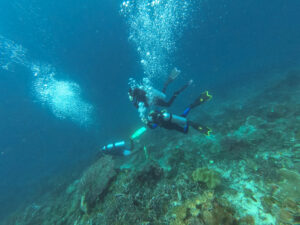What is Fogging?
Fogging refers to the condensation of moisture on the interior surface of a scuba diving mask, which can obscure vision and hinder underwater experiences. This phenomenon occurs when there is a significant temperature difference between the warm air inside the mask and the cooler water outside. As the diver exhales, moisture-laden air comes into contact with the cooler mask lens, resulting in condensation or fogging. Understanding the mechanisms behind fogging and how to prevent it is essential for ensuring a safe and enjoyable diving experience.
The Science of Fogging
Fogging is fundamentally a physical process driven by temperature and humidity differences. When a diver’s warm, moist breath comes into contact with the cooler surface of the mask lens, condensation forms. This occurs because the air inside the mask has a higher relative humidity compared to the air outside. When this moist air cools down upon contact with the mask lens, it reaches its dew point, causing water droplets to form on the surface. These droplets scatter light, creating a foggy appearance that can significantly impair visibility.
The chemical composition of the mask lens also plays a role in fogging. Most diving masks are made of tempered glass or polycarbonate, both of which can attract and hold water molecules. The microscopic texture of these materials provides a surface where water droplets can easily adhere. This is exacerbated when masks are not properly treated or cleaned, leaving residues that can promote fogging. The presence of salts and other minerals in seawater can also contribute to the formation of fog on the mask lens.
Moreover, the diver’s body heat and the temperature of the surrounding water influence fogging. In colder waters, the temperature gradient between the inside of the mask and the outside environment is more pronounced, increasing the likelihood of condensation. Conversely, in warmer waters, the difference is less stark, but fogging can still occur due to the high humidity levels. Understanding these scientific principles helps divers take proactive measures to mitigate fogging and maintain clear vision underwater.
Impact on Visibility
Fogging can have a profound impact on a diver’s visibility, significantly reducing their ability to see clearly underwater. This reduction in visibility can be particularly hazardous in various situations. For instance, during underwater navigation, poor visibility can make it difficult to read instruments or identify landmarks, increasing the risk of becoming disoriented. In environments with strong currents or limited light, the impairment caused by fogging can exacerbate these challenges, making it more difficult to maintain orientation and safety.
In addition, fogging can compromise communication between divers. Hand signals, which are crucial for underwater communication, become harder to interpret when visibility is impaired. This can lead to misunderstandings and potentially dangerous situations, especially in emergency scenarios where clear communication is vital. For underwater photographers and videographers, fogging can ruin shots, as the lens of the camera can fog up similarly to the mask, resulting in blurred and unusable footage.
Furthermore, fogging can detract from the overall enjoyment of the underwater environment. One of the main attractions of scuba diving is the ability to witness the beauty of marine life and underwater landscapes. When fogging occurs, this experience is diminished, as divers struggle to see their surroundings clearly. This can be particularly disappointing for divers who have traveled long distances to explore specific dive sites. Maintaining clear vision underwater is therefore essential not only for safety but also for maximizing the enjoyment and appreciation of the underwater world.
Common Factors Contributing to Fogging
Several factors contribute to the likelihood of fogging, each playing a unique role in the process. One of the primary factors is the temperature of the water compared to the air inside the mask. When diving in colder waters, the temperature difference is more significant, making condensation more likely. In contrast, warmer waters, while not immune to fogging, present a less severe temperature gradient but can still pose issues due to high humidity levels.
Another critical factor is the design and fit of the mask. Masks that do not fit well can allow more air to escape from the diver’s nose, increasing the humidity inside the mask and promoting condensation. Masks with inadequate ventilation can also trap warm, moist air inside, which then condenses on the cooler lens. Additionally, older masks or those with scratches and residues on the lens surface are more prone to fogging, as these imperfections provide nucleation points for water droplets.
The diver’s breathing patterns also influence fogging. Rapid or heavy breathing increases the amount of warm, moist air inside the mask, raising the relative humidity and the likelihood of condensation. Divers who are anxious or exerting themselves more than usual are particularly susceptible to this. Moreover, the initial preparation of the mask before entering the water can affect fogging. Masks that are not adequately cleaned or treated with anti-fog solutions are more likely to fog up during the dive.
Environmental conditions, such as high humidity and salinity, can also exacerbate fogging. In regions with high humidity, the air inside the mask is already saturated with moisture, making it easier for condensation to form. Similarly, in saltwater environments, the presence of salt particles can act as nuclei for condensation, increasing the frequency and intensity of fogging. Understanding these factors allows divers to take appropriate preventive measures and minimize the risk of fogging during their dives.
Preventive Measures
Preventing fogging is a key concern for divers, and several methods have been developed to address this issue. One common approach is the use of anti-fog sprays and gels, which can be applied to the inside of the mask lens before diving. These products work by creating a thin, hydrophilic layer that prevents water droplets from forming, thus maintaining clear vision. Commercial anti-fog products are widely available and generally effective, though their duration of effectiveness can vary.
Another popular preventive measure is the use of household items such as toothpaste or baby shampoo. These substances can be applied to the mask lens and then rinsed off, leaving a thin film that helps to reduce fogging. Toothpaste, especially those containing mild abrasives, can also help to remove residues and micro-scratches from the lens surface, further reducing the risk of fogging. Baby shampoo, being gentle and non-irritating, is a preferred choice for many divers, though it must be thoroughly rinsed to avoid eye irritation.
A traditional method to prevent fogging is the use of saliva. Divers spit into their masks and then spread the saliva evenly across the lens before rinsing it out with water. The enzymes in saliva create a protective film that can help to prevent condensation. While this method is cost-effective and convenient, its effectiveness can be inconsistent, and it may not be suitable for everyone due to hygiene concerns.
Proper mask preparation and maintenance are also crucial in preventing fogging. New masks often come with a silicone coating that needs to be removed before use. This can be done by scrubbing the lens with toothpaste or a specialized mask cleaner. Regular cleaning of the mask with mild detergents and thorough rinsing can help to remove oils and residues that contribute to fogging. Storing the mask in a cool, dry place and avoiding exposure to direct sunlight and extreme temperatures can also prolong its effectiveness and reduce the likelihood of fogging.
Proper Mask Care and Maintenance
Taking care of a diving mask is essential to prevent fogging and ensure its longevity. Regular cleaning is the first step in proper mask maintenance. After each dive, the mask should be rinsed thoroughly with fresh water to remove salt, sand, and other debris. A mild detergent can be used to clean the mask, ensuring that all residues are removed from the lens and skirt. It is important to avoid using harsh chemicals or abrasive cleaners, as these can damage the mask materials and promote fogging.
In addition to regular cleaning, periodic deep cleaning is recommended to remove any accumulated residues or biofilms. This can be done using a specialized mask cleaner or a mixture of water and white vinegar. The mask should be soaked in the solution for a few minutes, then scrubbed gently with a soft brush. This process helps to remove stubborn deposits and restore the mask’s clarity. After cleaning, the mask should be rinsed thoroughly and allowed to air dry completely before storage.
Proper storage of the mask is also crucial in preventing fogging. The mask should be stored in a cool, dry place away from direct sunlight and extreme temperatures. Exposure to heat and UV rays can degrade the materials and reduce the effectiveness of anti-fog treatments. It is also advisable to store the mask in a protective case or cover to prevent scratches and other damage. Keeping the mask separate from other diving equipment, particularly those with sharp edges or abrasive surfaces, can help to maintain its condition.
Replacing the mask skirt and strap when they show signs of wear can also help to prevent fogging. The skirt and strap should be checked regularly for signs of cracking, tearing, or loss of elasticity. Replacing these components ensures a proper seal and fit, reducing the likelihood of air and moisture entering the mask. Investing in a high-quality mask and maintaining it properly can significantly reduce the occurrence of fogging and enhance the overall diving experience.
Alternative Solutions and Technologies
Advancements in mask technology have led to the development of various solutions designed to combat fogging. One such innovation is the use of coatings and treatments applied to the mask lens during manufacturing. These hydrophilic coatings work by spreading water evenly across the lens, preventing the formation of droplets and maintaining clear vision. Some high-end masks come with these coatings pre-applied, offering a convenient and effective solution to fogging.
Another technological advancement is the development of masks with built-in ventilation systems. These masks feature small vents or channels that allow air to circulate within the mask, reducing the buildup of warm, moist air and minimizing condensation. Some models even incorporate small fans or heaters that actively prevent fogging by regulating the temperature and humidity inside the mask. While these advanced masks can be more expensive, they offer a high level of comfort and reliability for divers who frequently encounter fogging issues.
The use of anti-fog inserts is another alternative solution. These inserts are typically made of materials that absorb moisture, such as silica gel or special polymers. They can be placed inside the mask or attached to the lens, where they work to reduce humidity and prevent condensation. Anti-fog inserts are reusable and can be an effective and economical option for divers who experience persistent fogging.
In addition to these technological solutions, there are also specialized masks designed for specific diving conditions. For instance, masks with double lenses are designed to provide better insulation and reduce fogging in cold water. Similarly, full-face masks, which cover the entire face, offer improved air circulation and can significantly reduce fogging compared to traditional masks. These masks are particularly useful for divers who need to communicate using full-face communication systems, as they offer clear vision and enhanced comfort.
Diver Experiences and Recommendations
Experienced divers often develop their own strategies for managing and preventing fogging, based on their personal preferences and diving conditions. One common recommendation is to avoid touching the inside of the mask lens with bare fingers, as oils and residues from the skin can promote fogging. Using a microfiber cloth or lens tissue to clean the lens can help to avoid leaving smudges and fingerprints.
Another tip from seasoned divers is to acclimate the mask to the water temperature before entering the water. This can be done by rinsing the mask with the water from the dive site, allowing the lens to reach the same temperature as the surrounding environment. This practice helps to reduce the temperature gradient between the inside and outside of the mask, minimizing the likelihood of condensation.
Divers also emphasize the importance of proper breathing techniques to reduce fogging. Breathing slowly and evenly through the nose can help to control the amount of moisture inside the mask. Some divers find it helpful to practice breathing exercises on the surface before descending, ensuring they remain calm and avoid rapid or heavy breathing that can increase humidity inside the mask.
Personal experiences with various anti-fog products and methods vary, but many divers find a combination of approaches to be most effective. For example, using a commercial anti-fog spray in conjunction with proper mask cleaning and preparation can provide reliable results. Divers often share their success stories and preferred products with their peers, helping others to find effective solutions for their specific needs.
Ultimately, the best approach to preventing fogging is one that suits the individual diver’s preferences and conditions. Experimenting with different methods and products can help divers find the most effective strategy for maintaining clear vision underwater. Sharing these experiences and tips within the diving community contributes to a collective knowledge base that benefits all divers.
Key Takeaways
Managing fogging is essential for ensuring safety and enjoyment in scuba diving. Understanding the science behind fogging, recognizing the factors that contribute to it, and implementing effective preventive measures can help divers maintain clear vision underwater. Proper mask care and the use of advanced technologies further enhance the diving experience. By following the recommendations and experiences shared by seasoned divers, individuals can minimize fogging and fully appreciate the underwater world.

